| Reviews & Columns |
|
Reviews DVD TV on DVD Blu-ray 4K UHD International DVDs In Theaters Reviews by Studio Video Games Features Collector Series DVDs Easter Egg Database Interviews DVD Talk Radio Feature Articles Columns Anime Talk DVD Savant Horror DVDs The M.O.D. Squad Art House HD Talk Silent DVD
|
DVD Talk Forum |
|
|
| Resources |
|
DVD Price Search Customer Service #'s RCE Info Links |
|
Columns
|
|
|
Untouchables: Season 2, Volume 1, The
CBS DVD and Paramount have released The Untouchables: Season 2, Volume 1 on a four-disc, 16-episode set that should please fans of the gangbusting, rat-a-tat-tat actioner from the famed Desilu Studios. Starring Robert Stack as grim, humorless G-Man Eliot Ness, along with a host of excellent supporting players as various hoods, mobsters, psychotics and killers, The Untouchables: Season 2, Volume 1 metes out comic-book justice and violence with a refreshing vengeance.
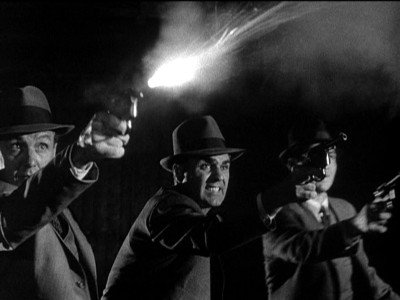
Admittedly, I was a little daunted at the task of reviewing this go-around of The Untouchables because previously, two of the best reviewers out there on vintage TV - DVDTalk's very own Stuart Galbraith IV and Phil Bacharach - had some mighty big reservations about the series, with the words "trite," "bland," "lethargic," "sluggish," and "wooden" used confidently despite the two's ultimate recommendation of the series. With those kinds of heavy-weight verdicts in the back of one's mind, a reviewer might start to think he's swimming against the tide when his own take on the show comes up on the other side. Watching The Untouchables, I found that I didn't necessarily disagree with Stuart's and Phil's pinpointing of the series' weaknesses - I just experienced those drawbacks differently.
Both Stuart and Phil provided excellent background on the show's production (please click here for Stuart's review, and here for Phil's), so I won't go into a lot of detail concerning the inception of the show. For newcomers to the series, however, The Untouchables, commissioned by that genuine TV genius Desi Arnez for his and his wife Lucille Ball's studio, Desilu, recounted the largely fictionalized accounts of real-life gangbuster Treasury Agent Eliot Ness, who, through the Bureau of Prohibition in Chicago, selected an elite team of incorruptible agents ("The Untouchables") charged with bringing down mob boss Al Capone. While his efforts at smashing Capone's illegal breweries did have an enormous impact on the crime leader's organization, it was actually agents working on a tax evasion angle that eventually nailed Capone. After Prohibition, Ness moved on to a job in local government in Cleveland, Ohio, tackling corruption and gangster activity there, returning briefly to work for the Feds in Washington before moving into the private sector. A memoir ghostwritten by Oscar Fraley largely re-wrote Ness' mob-fighting career, but it proved to be enormously popular, eventually spawning this ABC series. Ness died of alcoholism in 1957.
I mention that very brief rundown of Ness' career because you'll find almost none of that in this second season of The Untouchables. Fictionalized to the point of out-and-out fantasy (a fact that eventually caused the show to run disclaimers at the end of episodes due to pressure from, among other groups, former FBI men who objected to the show attributing their real-life efforts to Ness), the squeaky clean fictional Eliot Ness of The Untouchables bears little resemblance to the real-life Prohibition Agent whose career had many lows due to his drinking problem and his three divorces. His weekly exploits here are largely invented out of whole cloth, lifting real-life gangsters' names or events in mob history in order to plug in Ness and his Untouchables as a kind of roving, one-man crime-fighting machine of the entire Prohibition era.
While I would imagine most reviewers cool to the show didn't have a problem with this fictionalizing, I have noticed that a main bone of contention with The Untouchables is the portrayal of Ness himself, as essayed by resolute, emotionless, faintly inhuman Robert Stack. One-note in his performance to the point of almost kabuki-like stillness and gravity, Stack's Ness character is designed not so much as a living, breathing, emotionally layered person who engages in an epic battle with the mob, but as black-and-white enforcer of an ideal - justice - with no room for feelings or conflicts. The world exists, corruption is rampant, and Ness is a machine to bring that corruption to a halt. Of course, that kind of character construction can be viewed as distressingly flat and cardboard, as well. After decades of increasingly morally compromised "heroes" in our popular culture, Eliot Ness must look faintly ridiculous to viewers who want their heroes as divided and flawed as the times we live in today.
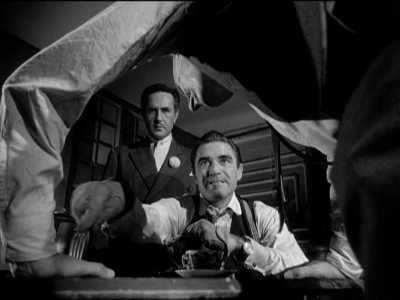
But precisely because of that throw-back nature of the Eliot Ness character, I found The Untouchables fairly exhilarating in its absolute refusal to bend to such shadings and gray-areas of characterizations. During The Untouchables original run from 1959 to 1963, the most popular, dominant genre on television - the western - had already moved firmly into its "adult" phase of psychologically-motivated, flawed characters operating within thinly disguised morality plays based on current sociological and societal concerns. But The Untouchables is having none of that. Entrenched in the bygone days of Prohibition, the show is immediately removed from then-current reality (a grim reality of the Cold War and the eminent threat of nuclear holocaust) right from the start, creating a storybook feeling to its structure that's heightened by the use of narration by Walter Winchell. With its period clothes, cars, and sets, The Untouchables is fantasy sifted through fable, reassuringly quaint and manageable with its small-time concerns (next to the A-Bomb) of Tommyguns and rumrunners. And therefore, The Untouchables works quite well within the confines of absolutes like "Good versus Evil," and "Right versus Wrong."
The Untouchables is a comic book vision of a world ruled by overwhelming violence and retribution, so the colorless, saintly Eliot Ness works perfectly as a relentless agent of destruction against the irredeemable foes of a civilized society. This isn't to say this adamantly one-note hero is preferable to a flawed, more recognizable and therefore, more sympathetic hero characterization - he's just determinedly "different" by comparison, and considering the increasingly sticky morass of hero/villains that are paraded in front of viewers then and now, a refreshing change of pace. As well, the rigidity and formalism of the show's structure and scripts - not at all unlike Jack Webb's production of Dragnet - works equally well within this comic-book fantasy, back during the era when published comic books had yet to fully incorporate into their heroes the psychological motivations and tensions increasingly found in other areas of popular culture.
There's a primitive power to the kind of elemental formalism of The Untouchables, which comes together perfectly in the bleak, solemn thesping of Robert Stack, in the thematic sameness of the scripts week after week, and in the high-voltage, sickening (for its time) violence of its action scenes. No doubt this last consideration - the series' controversial violence - is the key to the coming together of this fantasy world. Without the constant array of tortures and killings (this season includes grisly deaths by strangulation, guns, fire, along with various tortures), without the jolt of adrenalin that's injected into each story every time the Untouchables break out their rods and blast the villains, the stories themselves would be largely devoid of any dramatic interest. If Ness and his equally anonymous unit are a "force," rather than real characters, they must operate as "Forces," as inevitable powers that will not be swayed by corruption, and will not be felled by bullets. They must have the power of a force of nature equal to the sadism of their enemies, which lies not only in their .38s and their Thompsons, but in their relentless drive forward, unencumbered by superfluous emotions or shadings of personalities. For me, this aesthetic of The Untouchables is perfectly visualized in this season's highlight episode: the two-parter, The Big Train. A tightly constructed, marvelously entertaining episode, this John Peyser-directed show features a remarkable finale in a small town (actually the cramped Desilu backlot) where Ness battles Al Capone's men who lie in wait, ready to snatch the mob kingpin as he's transported by train to the newly constructed Alcatraz prison. When Ness has successfully infiltrated the town, and his men are ready to blow away the gangsters, he gathers together his men and in a show of unbending, unyielding Force, walks in a straight line down the street, Tommyguns spitting bullets, as the criminals are mowed down one by one. A splashy bit of derring do that makes no logical sense, this crude, electrifying sequence makes perfect sense in a comic book world where Ness isn't a human being, but a sullen, ghastly Angel of Death, an enforcer of justice, an inevitable, unstoppable Force of Good wiping out absolute Evil. It's an exhilarating sequence to this day, one that no doubt helped The Untouchables achieve Top Ten ratings success this second season.
The Untouchables, premiering on perennial rating's loser ABC in October of 1959, didn't make much of a splash during its first season, coming in 43rd for the year in the Nielsen's (it probably lost a good bit of the earlier The Real McCoy's audience to fading lead-in Pat Boone's Chevy Showroom). But word of mouth was such concerning the levels of violence the series was showcasing week after week, along with the various controversies involving Italian-American groups who objected to the predominance of Italian-named criminals featured, that buzz increased significantly over the summer of 1960. Hit-starved ABC, no doubt encouraged by the various controversies (there's no such thing as bad press when you're running in last place) probably turned a blind eye to the show's almost perverse delight in coming up with new ways to ventilate the bad guys. Staying at its Thursday 9:30pm time slot, and with new lead-in (and soon to be major hit) My Three Sons, The Untouchables shot into the Top Ten, landing at number eight for the year. Alas, it was to be a short run, a flash-in-the pan one-season phenomenon after the series tumbled back into relative obscurity the next year. All kinds of theories were put forth as to why the series was tanking (including all the protestors who claimed victory in bringing down the violent show), but I wonder if it was, ultimately, doomed to be obsolete right from the start. A vicious, primal, elemental fable translated to the Prohibition era, it fascinated audiences for a season with its mesmerizing violence and its seductively blank, enigmatic hero, before audiences got the message and moved on.
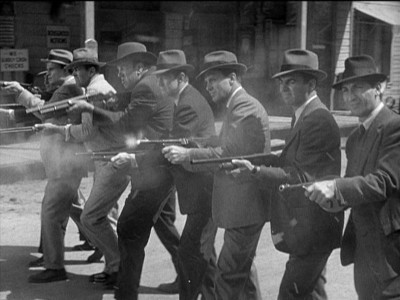
Here are the 16, one hour episodes of the four-disc box set, The Untouchables: Season 2, Volume 1, as described on the DVD insert. PLEASE NOTE: As with most vintage TV series released by CBS DVD/Paramount, there is a small disclaimer (smaller than normal, actually, with no prominent border box for this one) at the back of the DVD slimcase that states, "Some episodes may be edited from their original broadcast versions." There is no further explanation of what cuts, if any, were made. Edited TV shows are one of the hottest topics concerning DVD releases, and as a reviewer, I've taken both sides of the issue, depending on what title I'm reviewing. It's usually a case-by-case basis. I've always made it a point to state quite clearly that I don't have a "photographic" memory concerning old TV shows, and I don't have a vast library of taped broadcasts of thousands of TV shows that I can pour over and compare with current DVD releases. This explanation is usually enough for most of my readers, who understand no one person can be a certified authority on every TV show ever produced. However, with the growth of narrow-interest internet blogs and forums, small, vocal groups of "experts" on certain shows have taken it upon themselves to take umbrage at anyone else who dares to comment on "their" shows that they've studied and cherished over the years. While I genuinely admire their scholarship, I find some of these individuals use their expertise not so much in an academic spirit of openly sharing their knowledge with experts and novices alike - for the true love of the series and to further viewership - but as an elitist, cliquish bludgeon to denigrate and deride others less knowledgeable than themselves, as well as to somehow "connect" themselves with a series in a way that makes them feel as if they've inherited some kind of "mantle" by the creators because of their dogmatic devotion to the show. To those very, very few individuals, I dedicate this statement: I have no idea what might have been cut from The Untouchables: Season 2, Volume 1 episodes. Some of the episodes do feature the end credits "fictionalized" disclaimer that Desilu eventually slapped on the The Untouchables episodes, but not on all the episodes here. As well, there's what looks to be a new disclaimer at the beginning of The Big Train which states that the story is in no way an indictment of U.S. prison guards (I wonder what lawyer at Paramount recommended that one):
DISC ONE:
The Rusty Heller Story (October 13, 1960)
A beautiful woman pits two top-level mobsters against each other to get what she wants. But then Eliot Ness convinces her to help him.
Jack "Legs" Diamond (October 20, 1960)
"Legs" Diamond has gotten too much publicity, so the syndicate forces him to retire. But then he finds out about a shipment of narcotics and gets back into the game.
Nicky (November 3, 1960)
The teenage son of a bootlegger tries to kill Ness, believing he killed his father in a raid. So Eliot has him released, then follows him in order to find the distillery.
The Waxey Gordon Story (November 10, 1960)
Ness has trouble locating the breweries of a bootlegger who is also a Broadway impresario and has just taken control of the New Jersey beer syndicate.
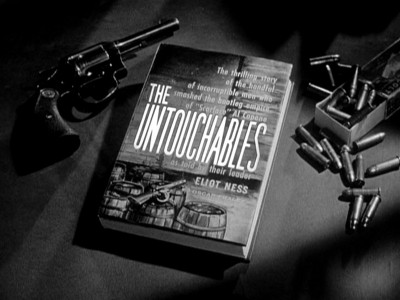
DISC TWO:
The Mark of Cain (November 17, 1960
A dope peddler in the mob is getting bad press. Now the old syndicate bosses want him to stop dealing, but he figures out a way to get around them.
A Seat on the Fence (November 24, 1960)
When he refuses to produce an incriminating letter from a source, a well-known radio broadcaster gets the squeeze - from both the mob and Eliot Ness.
The Purple Gang (December 1, 1960)
A Detroit gang is notorious for kidnaping criminals so their victims can't go to the police. But unbeknownst to them, one of their victims works for gangster Frank Nitti.
Kiss of Death Girl (December 8, 1960)
A club owner who stole three truckloads of liquor tries to romance his female blackjack dealer, who is famous for having boyfriends who end up dead.
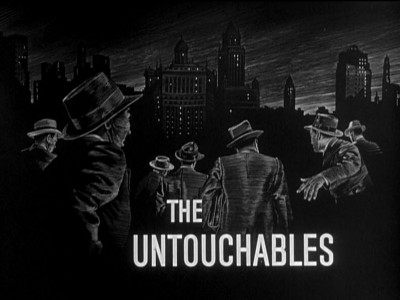
DISC THREE:
The Larry Fay Story (December 15, 1960)
The price of milk is being driven up as an extortion operation spearheaded by a nightclub owner whose world-weary girlfriend has been talking to Ness.
The Otto Frick Story (December 22, 1960)
The Nazi movement has come to America using mobsters to help organize the cause - including a big rally at Madison Square Garden that turns deadly.
The Tommy Karpeles Story (December 29, 1960)
Ness believes a convict sitting in prison for a train job is innocent. Now he needs to find the real brains behind the robbery, in which a million dollars was stolen.
The Big Train (Part 1) (January 5, 1961)
As kingpin Al Capone is about to be transferred by train from his prison in Atlanta to the newly built Alcatraz, Ness gets wind of a breakout attempt.
DISC FOUR:
The Big Train (Part 2) (January 12, 1961)
Al Capone's attempted breakout is to occur at a small, quite town in California. So when Ness and his men head there, they pose as members of Capone's gang.
The Masterpiece (January 19, 1961)
A hitman has the perfect plan for his next victim. He's going to kill a gunsmith with his own invention - a silent gun - right under the nose of Eliot Ness.
The Organization (January 26, 1961)
A boss sets up a big meeting to propose a coast-to-coast crime organization. But a just-released stool pigeon - and Eliot Ness - threaten his plan.
The Jamaica Ginger Story (February 2, 1961)
When two contract killers are hired to take out a crime boss who stole a shipment of deadly alcohol, one of them falls for a kindly schoolteacher.
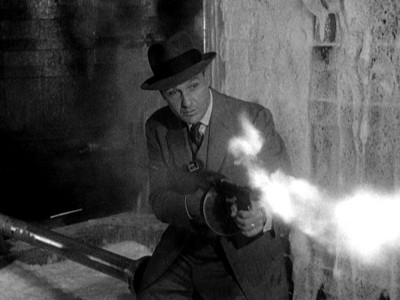
The DVD:
The Video:
The ful-screen, 1.33:1 video transfers for The Untouchables: Season 2, Volume 1 on the whole look quite good; individual scenes within episodes, though, vary as to grain and clarity. One shot can look crystal clear, with razor sharp edges and beautifully gray-scaled tones, while the next shot can look soft with heavy grain. I can only assume this is inherent in the original film elements. Overall, though, The Untouchables: Season 2, Volume 1 looks quite good.
The Audio:
The Dolby Digital English mono audio mix accurately reflects the original broadcast presentation - unless Paramount made some changes to the mix (either music cues or bumper announcements) - which I'm unaware of. All dialogue is cleanly heard. There's a Spanish mono mix available, along with English, Spanish and Brazilian Portuguese subtitles.
The Extras:
There are, unfortunately, no extras for The Untouchables: Season 2, Volume 1.
Final Thoughts:
Comic book to be sure, but also brutal, primal, elemental. The deliberately square, resolutely humorless and grim The Untouchables: Season 2, Volume 1 plays like a ancient fable of absolutes, of "Good" versus "Evil" and "Right" versus "Wrong." The violence is scintillating, and its absolute refusal to be motivated by anything other than one-dimensional characterizations and motivations, is refreshingly exhilarating. I highly recommend The Untouchables: Season 2, Volume 1.
Paul Mavis is an internationally published film and television historian, a member of the Online Film Critics Society, and the author of The Espionage Filmography.


|
| Popular Reviews |
| Sponsored Links |
|
|
| Sponsored Links |
|
|
| Release List | Reviews | Shop | Newsletter | Forum | DVD Giveaways | Blu-Ray | Advertise |
|
Copyright 2024 DVDTalk.com All Rights Reserved. Legal Info, Privacy Policy, Terms of Use,
Manage Preferences,
Your Privacy Choices | |||||||















